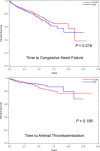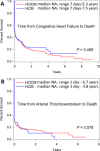International collaborative study to assess cardiovascular risk and evaluate long-term health in cats with preclinical hypertrophic cardiomyopathy and apparently healthy cats: The REVEAL Study
- PMID: 29660848
- PMCID: PMC5980443
- DOI: 10.1111/jvim.15122
International collaborative study to assess cardiovascular risk and evaluate long-term health in cats with preclinical hypertrophic cardiomyopathy and apparently healthy cats: The REVEAL Study
Erratum in
-
International collaborative study to assess cardiovascular risk and evaluate long-term health in cats with preclinical hypertrophic cardiomyopathy and apparently healthy cats: The REVEAL Study.J Vet Intern Med. 2018 Nov;32(6):2310. doi: 10.1111/jvim.15285. Epub 2018 Oct 16. J Vet Intern Med. 2018. PMID: 30417429 Free PMC article. No abstract available.
Abstract
Background: Hypertrophic cardiomyopathy is the most prevalent heart disorder in cats and principal cause of cardiovascular morbidity and mortality. Yet, the impact of preclinical disease is unresolved.
Hypothesis/objectives: Observational study to characterize cardiovascular morbidity and survival in cats with preclinical nonobstructive (HCM) and obstructive (HOCM) hypertrophic cardiomyopathy and in apparently healthy cats (AH).
Animals: One thousand seven hundred and thirty client-owned cats (430 preclinical HCM; 578 preclinical HOCM; 722 AH).
Methods: Retrospective multicenter, longitudinal, cohort study. Cats from 21 countries were followed through medical record review and owner or referring veterinarian interviews. Data were analyzed to compare long-term outcomes, incidence, and risk for congestive heart failure (CHF), arterial thromboembolism (ATE), and cardiovascular death.
Results: During the study period, CHF, ATE, or both occurred in 30.5% and cardiovascular death in 27.9% of 1008 HCM/HOCM cats. Risk assessed at 1, 5, and 10 years after study entry was 7.0%/3.5%, 19.9%/9.7%, and 23.9%/11.3% for CHF/ATE, and 6.7%, 22.8%, and 28.3% for cardiovascular death, respectively. There were no statistically significant differences between HOCM compared with HCM for cardiovascular morbidity or mortality, time from diagnosis to development of morbidity, or cardiovascular survival. Cats that developed cardiovascular morbidity had short survival (mean ± standard deviation, 1.3 ± 1.7 years). Overall, prolonged longevity was recorded in a minority of preclinical HCM/HOCM cats with 10% reaching 9-15 years.
Conclusions and clinical importance: Preclinical HCM/HOCM is a global health problem of cats that carries substantial risk for CHF, ATE, and cardiovascular death. This finding underscores the need to identify therapies and monitoring strategies that decrease morbidity and mortality.
Keywords: arterial thromboembolism; asymptomatic; congestive heart failure; epidemiology; incidence; outcome; survival.
Copyright © 2018 The Authors. Journal of Veterinary Internal Medicine published by Wiley Periodicals, Inc. on behalf of the American College of Veterinary Internal Medicine.
Figures








References
-
- Fox PR. Spontaneous animal models In: Marcus FI, Nava A, Thiene G, eds. Arrhythmogenic RV Cardiomyopathy/dysplasia Recent Advances. Italia: Springer‐Verlag; 2007:69–78.
-
- Liu SK, Fox PR. Cardiovascular pathology In: Fox PR, Sisson DD, Moise NS, eds. Textbook of Canine and Feline Cardiology Principles and Clinical Practice. 2nd ed. Philadelphia, PA: WB Saunders; 1999:817–844.
-
- Fox PR, Basso C, Thiene G, Maron BJ. Spontaneously occurring restrictive nonhypertrophied cardiomyopathy in domestic cats: a new animal model of human disease. Cardiovasc Pathol. 2014;23:28–34. - PubMed
-
- Fox PR, Maron BJ, Basso C, Liu SK, Thiene G. Spontaneously occurring arrhythmogenic right ventricular cardiomyopathy in the domestic cat: a new animal model similar to the human disease. Circulation 2000;102:1863–1870. - PubMed
Publication types
MeSH terms
LinkOut - more resources
Full Text Sources
Other Literature Sources
Research Materials
Miscellaneous

